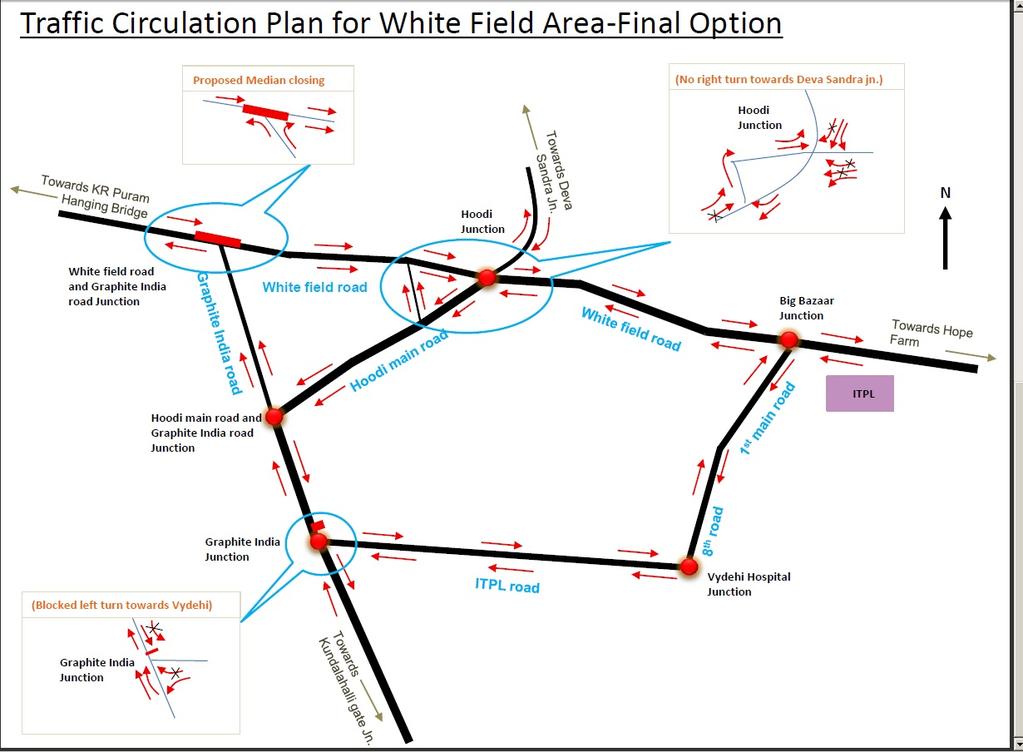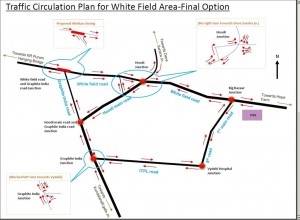Whitefield Mobility Vision FAQs

Whitefield’s traffic is a Mess. What are the top things that will make a “sustainable” impact to us all? What is the Mobility Vision?
The traffic re-routing plan is only one piece of a vast puzzle. The police planners are fully aware (as pointed by many commentators on social media) that a couple of one-ways here and there are not a magic wand that will obliterate traffic jams. Yes, we need smooth, pot-hole free roads — if that means we have to fix underground leakages. Yes, we need unobstructed footwalks — if that means we have to move electric transformers. Yes, we need alternates to motorized transport. Yes, we need bicycling pathways. Car-pooling, public transport. Yes, we need proper urban design. Yes, we need several alternate routes. Yes, we should not force rush-hour traffic through tranquil residential neighbourhoods.
How to coherently gel together these ideas, how to convince elected officials and civil servants to release funds, how to mobilize support, and perhaps most importantly, how to execute in an non-corrupt and efficient manner. We grapple with these questions, but I have no doubt in my mind that we’re within grasp of the answers.
What projects are you working on
As far as urban mobility is concerned, we’re working on all the projects mentioned in the answer to the last question. Thus: Good street design. Fast land acquisition for road-widening. Fixing of underground leakages. Asphalting of key roads. Encouraging different agencies (BWSSB, BMTC, BBMP, BTP, Bescom, OFC, etc.) to co-ordinate their activities. Creation of bicycling paths. Creation of bus bays that don’t block traffic. Educating BMTC drivers to use bus bay locations. Rationalizing bus routes so too many don’t go empty. Encouraging police to assert their enforcement authority in a non-corrupt fashion. Lobbying for Commuter Rail.
What is the “essence” of the recent Traffic plan implementations at ITPL/Hoodi area?
The essence of the traffic plan is to give maximum priority to the direction of maximum traffic flow. It is observed that the amount of traffic travelling in a rush-hour direction dwarfs the opposing traffic by a factor of 10-to-1 or even 100-to-1. For example, during morning rush hour at Graphite India, the Northbound Cosmos Mall-to-SAP labs traffic vastly outnumbers the Southbound Keys Hotel-to-RxDx Telerad traffic. Thus a single Southbound vehicle that holds up the junction can cause an order-of-magnitude number of Northbound vehicles to stall.
Giving maximum priority to the direction of max flow is the same principle that is used when right-turns are banned at T-junctions causing right-turn-traffic to use a U-turn-followed-by-left-turn.
The price of the plan is that lower-intensity traffic flows will need to suffer a U-turn. And if the U-turn does not have a weaving lane (always the case in Bangalore), a jam may well be created there. We see this effect at the Ginger U-Turn and at the Hanuman Temple U-turn.
So this is a work in progress. The police planners are monitoring the situation, continuously update the plan.
There is however only so much a traffic plan can do. It may make flow less turbulent by virtue of median closures and generally reduce chaos. But in the end it can help only if the traffic is less than 1.5-2 times the design capacity of the road. At present, traffic is 3-to-5 times design capacity. Thus more capital intensive (and hence time-consuming) measures seem inevitable. Just as well is the ordinary citizen’s resolve to reject single-occupant cars and motorized or private vehicles in favour of car-pooling, public transport and bicycles.
What was the “rationale” behind this ?
There is a utilitarian philosophy driving all of this — that is, to maximize the total benefit while minimizing the inevitable negative consequences. Certainly some people will experience longer distance-traveled. But the hope is that most people will experience lesser time spent on the road.
This is only part of the traffic puzzle, and by no means is it a silver bullet.
What is Whitefield Rising’s role in all this?
Whitefield Rising is a citizen’s movement that encourages government officials to discharge their duties in a non-corrupt and efficient manner. To this end, Whitefield Rising volunteers do often get into the contractual and operational details of many projects. Whitefield Rising is a platform for ordinary citizens to be able to influence civic issues in a way that helps most people. Indeed, in the case of the traffic plan, Whitefield Rising collected inputs from many citizens, consolidated and presented it to the police, which in turn adopted (after modification) certain aspects of Whitefield Rising’s plan. To this day, Whitefield Rising continues to try to influence the traffic plan based upon inputs received from ordinary commuters.
Whitefield Rising volunteers are not paid, nor do they have the final say in any aspect of an urban project such as a traffic plan.
Whitefield Rising also encourages individuals to form local governing councils that are funded independently by member-housing-societies, so that localities can start “owning” their streets, their parks and indeed their common problems. In this way, Whitefield can improve, at least in microscopic pockets, independent of the BBMP.
But its caused a mess at some other places. Has it really worked?
This has been addressed in “What is the “essence” of the recent Traffic plan … ”
Now who will work on the “mess” in some of the areas?
Again, addressed in “What is the “essence” of the recent Traffic plan …”
I want to really help, but I am not qualified in anyway. What can I do?
Formal or academic qualifications are not much of a hurdle, but being a serious Whitefield Rising volunteer is a commitment of time and energy. It involves considerable thinking, and also much time pounding the pavements. If you think you qualify, please send email to hello@whitefieldrising.org and include the following details.
- Name:
- Phone Number:
- Prior involvement in any urban or civic issue:
- A description of a prior problem that you were instrumental in resolving, and that you are most proud of.
- Is there a particular problem you wish to resolve by making use of Whitefield Rising
 resources? If so, please describe the particular problem. Please also explain why you believe becoming a Whitefield Rising volunteer would empower you to resolve that problem.
resources? If so, please describe the particular problem. Please also explain why you believe becoming a Whitefield Rising volunteer would empower you to resolve that problem. - Are you or your family members part of any social organization?
- Are you or your family members part of any political party?
Authors: Arvind Keerthi & Nitya Ramakrishnan

It has been a year since this has been implemented.
It is probably a good time to take feedback from actual users on if this has really been a change for the better or worse?
I for one , believe that each of the changes have been counterproductive and no real purpose has been served by the change.
Can we do a poll to find out?